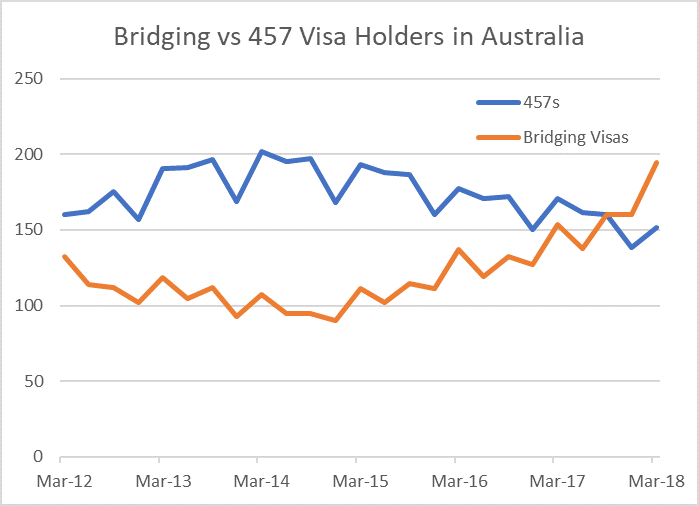Employers Beware – Bridging Visas Now More Common than 457 Visas

Figures released by the Department of Home Affairs indicate that as of 31 March 2018, there are more Bridging Visa holders in Australia than 457 visas.
The number of holders of 457 visas continues to decline – from a high of 201,558 in March 2014, were 151,591 457 visa holders in Australia as of 31 March 2018.
On the other hand, the number of Bridging Visa holders has grown significantly – from a low of 92,906 in December 2013, there were 194,875 bridging visa holders in Australia as of 31 March 2018.
This number is also much higher than the total number of working holiday makers in Australia – the number of subclass 417 holders in Australia was 132,093 as of 31 March.
The largest cohort of temporary visa holders in Australia continues to be the NZ Special Category Subclass 444 visa at 669,115 holders, followed by Student Subclass 500 visa holders at 391,246.
All up, the report indicates that there are 2.2 million temporary visa holders in Australia. This figure excludes provisional temporary visa holders such as temporary partner, general skilled and business skills visa holders, so the number of temporary visa holders is actually higher than this.
What is a Bridging Visa?
The general idea of a bridging visa is that it allows a person to stay lawfully in Australia whilst they are going through an immigration process.
A bridging visa is generally granted where:
- A person has applied for a substantive visa whilst in Australia – in this case, the bridging visa allows them to remain in Australia whilst their application is being processed; or
- The person has had a visa application refused whilst in Australia, but has appealed the decision to the Administrative Appeals Tribunal or Federal Court; or
- The person is making arrangements to depart Australia or lodge a further visa application or appeal
Why Are There So Many Bridging Visa Holders in Australia?
There are several reasons why there are more bridging visa holders in Australia than previously:
- Processing times for visa applications have increased – this means that onshore visa applicants spend more time in Australia on bridging visas awaiting their outcomes
- Refusal rate for visa applications has increased – this means that there are more applicants appealing to the Administrative Appeals Tribunal, and waiting on bridging visas for their decision
- More temporary visa holders are being cancelled (eg for character issues), and may hold bridging visas during the appeal process
Can I Employ Staff on a Bridging Visa?
You can employ bridging visa holders, providing they have appropriate work rights. Verifying work rights for Bridging Visa holders is much more complicated compared to 457 or Working Holiday Makers.
The general rule is that the bridging visa will have the same work rights as the visa the person held prior to making the application which led to the bridging visa.
However, many bridging visas are granted with full work rights – for example if applying for General Skilled Migration, a Graduate Temporary Visa or a Temporary Partner visa onshore.
On the other hand, if the visa holder has a chequered visa history, they may have been granted a Bridging E or Bridging C visa – which generally do not have work rights.
How Often Should I Check Work Rights for Bridging Visa Holders?
Bridging visas generally cease within 35 days if a decision is made to refuse the underling visa application which led to the bridging visa.
Accordingly, we recommend that you check work rights for Bridging Visa holders at least once a month.